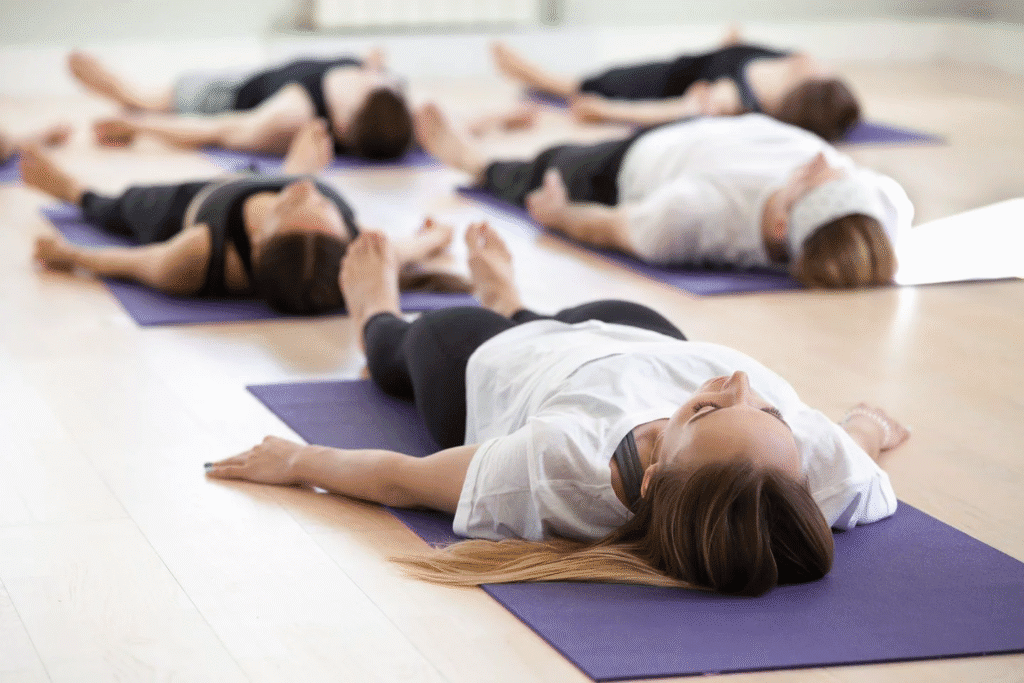Finding times of real calm is becoming harder in the quick-paced environment of today. Whether it be work stress, personal concerns, or the ubiquitous technology, the continual noise of our daily life frequently leaves us exhausted and isolated. This is where yoga nidra, a strong relaxation method, may provide great advantages. Known as “yogic sleep,” Yoga Nidra is a guided meditation method that lets you reach a condition of intense relaxation and cognitive clarity without actual sleep. This blog will cover what Yoga Nidra is, its advantages, and—most importantly—how to practice it progressively.
What is Yoga Nidra?

Yoga Conscious relaxation is Nidra. You stay alert and awake during the technique, though your body and mind reach a condition of profound relaxation, so it differs from conventional sleep. Yoga describes union or integration; Nidra is drawn from the Sanskrit word for sleep. Therefore, Yoga Nidra means “yogic sleep,” a state wherein the mind and body reach a degree of rest akin to that of sleep but with a heightened awareness.
During Yoga Usually, Nidra, the practitioner is led through several phases of relaxation by either a teacher or a tape. The aim is to bring the body and mind into a deep state of peace, therefore enabling the practitioner to connect with their inner most being. The habit is extremely healing and can be a great means to fight anxiety, worry, and sleeping problems.
Benefits of Yoga Nidra

Many advantages for both the body and the brain are provided by yoga Nidra. Some of the most important ones are:
1. Reduces Anxiety and Stress: Yoga Nidra activates the parasympathetic nervous system, therefore inducing the body’s relaxation response and hence lowering stress levels and worry.
2. Improves Sleep Quality by Doing Yoga. Many individuals claim that their sleeping patterns have gotten better with Nidra. The intense relaxation promotes a sleep-like condition, therefore aiding the body’s self-healing process.
3. Promotes Mental Clarity: Regular practice of Yoga Nidra helps clear mental fog and enhances focus, as the practice allows the brain to relax and reset.
4. In a very relaxed state, the subconscious mind is more open to creative ideas and breakthroughs.
5. Yoga Nidra can help release physical tension and muscle tightness, therefore increasing general bodily relaxation.
6. Equilibrium Emotions: The practice’s promotion of self-awareness can enable people to become more sensitive to their emotional conditions and so better control them.
7. Yoga increases energy levels. Nidra offers a fantastic method to revive vitality and energy without requiring hours of sleep. A half-hour session can be as restorative as a full night of sleep.
Ways to Prepare for Yogic Sleep
You should arrange your surroundings and mind in a manner suitable for relaxation before starting. These are a few easy ways to get ready:
1. Find a quiet place that won’t be interrupted. This could be a quiet room in your house, a serene park, or any other placid setting.
2. Make sure your environment is pleasant. To lie on, you might want a yoga mat, cushion, or blanket. Being physically at ease during the exercise will help you to completely unwind.
3. Stay away from tight or limiting attire; wear loose-fitting clothing. Loose-fitting, comfy clothing will let you relax and unwind.
4. Shut off any noise that could disturb your practice, silence your phone, close windows, or turn off distractions.
5. Before you start, consider what you hope to get from this session. It could be emotional therapy, stress alleviation, or just energy restoration. This goal will direct your practice and assist you in keeping focused.
Steps-by-step guide for doing yoga nidra
Yoga is normally broken out into many phases, and Nidra is meant to lead the practitioner into a more profound state of relaxation at each step. The phases of a Yoga Nidra session are broken down here simply.
1. Setting an Intention (Sankalpa)
You are asked to establish a Sankalpa, sometimes known as an intention, at the beginning of the practice. This might be a wish, confirmation, or personal aim. It should be short, obvious, and favorable. For instance, I am strong and assured, or I am at peace with myself. You have this aim in mind all through the session; the theory is that as you unwind, your subconscious will try to materialize this intention.
2. Body scan turns on awareness
The following stage in Yoga Nidra is a body scan—that is, consciousness rotation—guided either by the instructor or by a recording. One by one, awareness of many sections of your body helps to release stress and link you with the feelings of your body. You may Be instructed to mentally record every area of your body as awareness shifts from the tips of your toes to the crown of your Common body parts included in the scan are:
- Left foot, right foot
- Right leg, left leg
- Pelvis, belly, chest, arms
- Head, face, neck
Let it relax and let go of any tension or pain as you mentally scour every corner.
3. Breathing awareness
The breath takes over when the body scan is finished. You will be led to become mindful of your breathing and to observe its organic pattern. The instructor might recommend watching the feeling of breathing entering and leaving your body, or you might concentrate on the movement of your stomach. This level supports more relaxation and helps the mind to quieten even further. You could sometimes exercise Nadi Shodhana, or alternate nostril breathing, which is renowned for its relaxing properties.
4. Emotions and Sensations (Opposite Sensations)
Now the instructor could lead you to feel opposing emotions or feelings. This could entail seeing happiness and sadness, weight and lightness, or warmth and cold. These opposites enable the mind to be balanced and enable the development of more awareness of the transient character of feelings and emotions. The aim here is to see any specific emotion and let it fade rather than to get connected to it.
5. Visualization
At this point, you will be directed through several images. These could be images of symbolic items, quiet settings, or nature. By stimulating your imagination and senses, visual methods enable you to deepen your degree of relaxation. Some examples are walking through the woods, envisioning light entering your body, or visualizing a tranquil lake. The more vivid the image, the more successful it is in encouraging great relaxation.
6. Deep Relaxation State (Yoga Nidra)
You most likely have fallen into a state of profound relaxation now in the workout. Your body and mind are still; you might be in a state between wakefulness and sleep or feel yourself drifting. The aim at this level is to keep a delicate equilibrium between being vigilant and very calm. Your unconscious mind becomes most receptive here, and good changes start to establish themselves.
7. Confirmation of Sankalpa
Following your thorough relaxation, you should revisit your intention (Sankalpa) that you started at the beginning. This builds your conviction or affirmation even further in your subconscious. To solidify its influence, one can mentally say it several times.
8. Gradual awareness comeback
The last step of Yoga Nidra is the slow comeback to everyday consciousness. The teacher will help you gradually return your awareness to the body and the environment. Deepening the breath, noticing the sensations in the body, and eventually opening the eyes softly all help in this process. Not hurried, this process lets the calm totally incorporate itself.
Conclusion
Yoga Offering deep relaxation and both physical and mental advantages, Nidra is a potent method. This exercise is not just for yogis or seasoned practitioners; anybody may profit from it, whether you’re under stress, having sleep problems, or merely want more mental clarity. Regular practice will start to show you changes in your general well-being, maybe even turning one of your favorite self-care instruments.
By gaining knowledge about Yoga practice, you may reconnect with yourself on a deeper level, minimize the clutter of daily life, and grow more inner tranquility. Thus, whether you are a novice or a seasoned professional, think about including Yoga Nidra into your daily schedule and see the changing influence of this lovely discipline.





